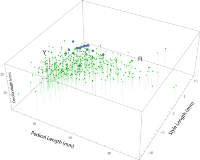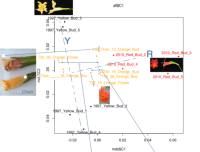Sevi's Garden Experiment audio->
Das Schlüsselexperiment DE | The Key Experiment |
Im Jahr 1996 wurde von uns eine "Long-Term Monitoring Site" im Rainbow Canyon Valley errichtet. Es gab dort eine grosse Population mit neben einander wachsenden gelbblühenden, orange blühenden und rot blühenden Individuen von Diplacus (Mimulus) aurantiacus. Die Blüten, obwohl farblich variabel, unterschieden sich nicht sehr in ihrer Gestalt. | In 1996, we set up a "Long-Term Monitoring Site" in the Rainbow Canyon Valley. There was a large population of yellow-flowering, orange-flowering, and red-flowering individuals of Diplacus (Mimulus) aurantiacus growing side by side. The flowers, although variable in color, did not differ much in their shape. |
dazu 1 Bild aus der Epoche: | picture from the epoch: |
digitalisierte Analogaufnahme
digitized analogue recording
An der unteren rechten Ecke des Bildes sieht man eine gelb-blühende Pflanze neben der damals ein weggeworfener Garten-stuhl lag. Aus dieser Begebenheit erhielt die Pflanze schliesslich die Bezeichnung «CHAIR». | At the lower right corner of the picture, you can see a yellow-flowering plant next to the garden chair that was thrown away. (Not seen in the picture) From this incident, the plant finally got the name "CHAIR". |
Von «CHAIR» handelt die folgende Untersuchung. Die Pflanzen in dieser Population befinden sich in «Transition» also in einem Uebergangs-zustand. Diese wandeln sich im Laufe der Zeit - jede Pflanze für sich - von einem gelbblühenden insektenbestäubten Individuum in ein rotblühendes Kolibri-bestäubtes Individuum um. | From «CHAIR» the ensuing investigation comes. The plants in this population are in transition e.g. in a transitional state. Over time, each plant individually transforms from a yellow-flowered insect-pollinated individual into a red-flowered hummingbird-pollinated individual. |
Alle Individuen in einer Transitionspopulation zeigen eine ähnliche Charakteristik der Umwandlung. Nur die Pflanze «CHAIR» verhält sich etwas anders in dieser Beziehung: | All individuals in a transition population show a similar characteristic of the transformation. Only the plant «CHAIR» behaves differently in this relation: |
Die Pflanze zeigt eine Veränder-ung ihre Blütenfärbung von hellgelb zu dieser eidotter-gelben Färbung in den Jahren zwischen 2001 bis 2011. An diesem Farbort angelangt, präsentierte sich die Blüte farbstabil (Pfeilspitze). Ihre Blütenfärbung änderte sich - entgegen unserer Erwartung - jahrelang nicht mehr. Doch mittelfristig sollten auch diese Pflanze einmal die rote Blütenfarbe annehmen. Das war zumindest unsere anfängliche Annahme. | The plant shows a change in its flower color from pale yellow to this egg yolk-yellow color in the years between 2001 to 2011. Having reached this color location, the color of the flower presented color-stable (arrowhead). The flower color changed - contrary to our expectation - for years no longer. But in mid-term also this plant should achieve once the red flower color. At least that was our initial assumption. |
Blüten von CHAIR in einem halbstabilen Zwischenstadium
Hypothese: Vielleicht lässt sich dieser Phänotyp durch einen gezielten Umweltdruck in Richtung rotblühende Pflanze verändern? Severin - der Sohn des Autors - hat eine Pflanzenanlage gebaut, die 10 km westlich vom Naturstandort «CHAIR» zu stehen kam. Wir nannten diese Anlage «Sevi's Garden». In dieser wurden 6 Stecklinge von CHAIR kultiviert und einfach in diesen etwas unwirtlichen Aussenbedingungen wachsen gelassen. Das war im Jahr 2011. Die Pflanzen wurden eine Zeit lang bewässert und auch etwas schattiert. | Hypothesis: Perhaps this phenotype can be changed by a targeted environmental pressure in the direction of a red flowering plant? Severin - the author's son - has built a plant facility 10 km west of the natural site "CHAIR." We called this facility "Sevi's Garden." In this six cuttings of CHAIR were cultivated and grown merely in these somewhat competitive outdoor conditions. That was in 2011. The plants were watered for a while and also a bit shaded. |
Im Jahr 2012 würden die Blütenknospen ein erstes Mal verglichen. Es zeigten sich kaum sichtbare Farbunterschiede. | In 2012 the buds were compared for the first time. Pigment differences are faintly visible. |
Bild: «Sevi's Garden» im Jahr 2013 | Image: "Sevi's Garden" in 2013 |
In diesem Jahr wurden Blü-ten «Chsevi» mit Blüten der Originalpflanze zum 2. Mal verglichen. | This year flowers "Chsevi" were compared with flowers of the original plant for the second time. |
Links Blüten einer Steckling-pflanze «Chsevi», rechts Blüten der Originalpflanze «CHAIR». Minimale farbliche Korollen-Unterschiede sind erkennbar. Die Kelche links sind pigmentiert, rechts nicht pigmentiert. Der Vergleich wurde im Jahr 2014 für Knospen, aber auch für frisch geöffnete Blüten erneut gemacht. | On the left flowers of a cutting plant «Chsevi», on the right flowers of the original plant «CHAIR». Minimal color hue differences are visible. The calyces on the left are pigmented, on the right not pigmented. The comparison was repeated in 2014 for buds, but also for freshly opened flowers. |
oben: Knospe einer Stecklingpflanze «Chsevi» unten: Knospe Originalpflanze «CHAIR» (2014) | above: bud of a cutting plant «ChSevi» bottom: bud original plant «CHAIR» (2014) |
Frisch geöffnete Blüten der Pflanzen. Oben: Steckling «Chsevi», unten: Originalpflanze «CHAIR" (2014). Hier sind nicht nur beträchtliche Farbunterschiede, sondern erstmals auch Formunterschiede zu sehen. Nun hat man Samen durch eine Selbstbestäubung der Wildpflanze "CHAIR" einerseits, wie auch durch Selbstbestäubung der Pflanze aus Sevi's Garten «Chsevi» andererseits gewonnen. Aus den Samen der beiden Varianten von «Sevi» wurden blühende Pflanzen gezogen. Die beiden Plots des Farbenraumes der Nachkommen - aus diesen beiden Varianten - sind nachfolgend dargestellt. | Freshly opened flowers of the plants. Top: "Chsevi" cuttings, below: Original plant "CHAIR" (2014), not only showing considerable color differences but also differences in shape for the first time. Now, seeds have been obtained by self-pollination of the wild plant "CHAIR" on the one hand, and by self-pollination of the plant from Sevi's garden "Chsevi" on the other. From the seeds of the two variants of "Sevi" flowering plants were grown. The two plots of the color space of the offspring - from these two variants - are shown below. |
| |
Lab-Plot für die Nachkommen von «CHAIR» Lab plot for the offspring of «CHAIR» | Lab-Plot Für die Nachkommen der Stecklingpflanze «Chsevi» Lab plot for the descendants of the cutted plant «Chsevi» |
Abgebildet 9 Nachkommen der Stecklingpflanze «Chsevi» (Chsevi x Chsevi) | Pictured 9 descendants of the cuttling plant «Chsevi» (Chsevi x Chsevi) |
Plot: Blütengrösse der Chsevi-Nachkommen, die sich zwischen roten (R) und gelben (Y) Blütenformen im "Phasenraum" ein-mitten. Hellgrüne Punkte: 180 Individuen eines West-Ost-Transsekts. Wie lässt sich das ganze deuten? Chsevi ist ein Klon von CHAIR und sollte von der Blüten-Gestalt her mit der Mutterpflanze identisch sein. Nach einer räumlichen Trennung (Stecklinge von der Originalpflanze) für wenigstens drei Jahre, treten nach und nach erhebliche Blüten-Gestalt-Unterschiede bei einer der sechs Klon-Pflanzen auf. Zudem unterscheidet sich dieser Klon genetisch von der ursprünglichen Pflanze. «Chsevi» hat sich unter dem neuen Regime (grosse Hitze und Trockenheit) als Phänotyp verändert. Bei den Nachkommen dieses Pflanzen-Klons kann man diese (epi-)genetische Veränderung eindeutig nachweisen. Denn die Nachkommen zeigen das Farb-Merkmal (rot) zu 84 %. Die Nachkommen der nicht epimutierten 5 Klon-Pflanzen zeigen dieses Merkmal nicht. Zu 5-20% zeigt jedoch das Merkmal «rote Farbe» bei den Nachkommen von «Chsevi» im alten Zustand. - Die Mutter-pflanze andererseits hat sich am Wildstandort auch 2017 - weder von der Blütengestalt noch genetisch verändert; sie blieb stabil. Soviel zur Färbung der Blüte. Die Blütengestalt dieses Klons ist bei den Nachkommen nur wenig verändert. Die Streuung ist hier bemerkenswert klein. Von der Form her scheinen diese Blütenformen weder eindeutig «gelb» noch eindeutig «rot» zu sein; es ist eine Zwischenform. | Plot: Flowering size of the "Chsevi" offspring, which is in between the red (R) and yellow (Y) flower forms in the "phase space". Light green dots: 180 individuals of a West-to-East transect. How is the whole thing interpreted? Chsevi is a clone of CHAIR and should be identical in shape to the mother plant. After a spatial separation (cuttings from the original plant) for at least three years, a gradually considerable flower-shape difference appeared in one of the six clone plants. Also, this clone is genetically different from the original plant. "Chsevi" has changed as a phenotype under the new regime (high heat and drought). In the offspring of this plant clone, this (epi-) genetic change can be demonstrated. Because the progeny shows the color characteristic (red) to 84%, the progeny of the non-epimutant clone plants does not have this trait. However, at 5-20% the characteristic "red color" in the descendants of "Chsevi" shows still the old condition. - The mother plant on the other hand, has not changed in the wild location, also in 2017 - neither the flower shape nor genetically; the flower remained stable. So much for coloring of the flower. The flower shape of this clone is little changed in the offspring. The scattering is remarkably small here. Regarding shape, these flower forms do not appear to be apparently "yellow" or clearly "red"; it is an intermediate form. |
Die Befunde können sowohl epigenetisch als auch genetisch interpretiert werden. Wenn man genauer betrachtet, was in der Anhang folgt, muss man schließen, dass eine solche Änderung sowohl eine genetische als auch eine epigenetische Notation hat. | The findings can be interpreted both epigenetically and genetically. |
Ergänzung: Bei einer genomischen Hauptkomponentenanalyse wird der gelbe Morph von Chair entlang einer Linie gelber Formen (Y) gruppiert, während der schmutzige rote und transformierte Morph in die roten Formen gruppiert wird (R, orthogonal zur imaginären Linie). Daraus folgt, dass sich die Kontrollfarbgene während des Übergangs genetisch verändert haben müssen, da ein Kontrollgen der gelben Form nicht funktionsfähig ist und die Anthocyanbiosynthese im Blütengewebe nicht beeinflussen kann.
|
Supplement: In a genomic principal component analysis, the yellow morph of Chair is grouped along a line of yellow shapes (Y), while the dirty red and transformed morph is grouped into the red shapes (R, orthogonal to the imaginary line). It follows that the controlling color genes must have changed genetically during the transition (gain of function) because a control gene of the yellow form is not functional and cannot influence the anthocyanin biosynthesis in flowers. |
r.b 11-07-18 Niederurnen Switzerland











